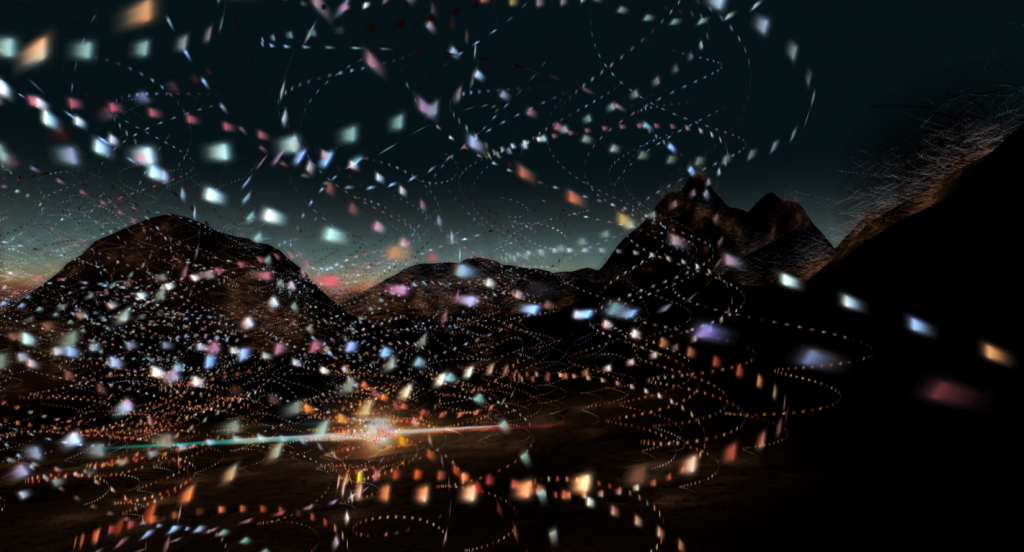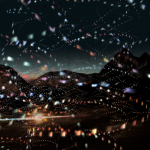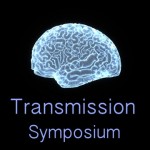
Researchers from Bournemouth University and the University of Glasgow have been shortlisted for the Lumen Prize for their project AfterGlow, which shows the transmission of an infectious disease through 3D animation.
Their work forms part of Silent Signal, a collaborative project produced by Animate Projects and funded by the Wellcome Trust, bringing together animation artists and biomedical scientists to create experimental animated artworks. The resulting artworks are designed to make us think again about science and the human body.
BU animation research lecturers, Paul Smith and Vicky Isley, have been working with Dr Paddy Brock, a Research Associate at the University of Glasgow to explore the transmission of malaria. Their completed real-time animation shows the spread of the disease through the dancing patterns of mosquitoes at twilight – their prime feeding time.
The animation shows the island terrain lit up by glowing trails of light, mimicking mosquito flight patterns. These spirals represent blood droplets carried by the mosquitoes, infected with Plasmodium knowlesi, a malaria parasite recently found to jump the species barrier from monkey to human. The infection left in the wake of Macaque monkeys as they roam the island for food, demonstrates the intricate relationship between disease transmission and its environment.
Together Paul and Vicky form boredomresearch, an artistic collaboration which is renowned for creating artworks that explore extended time frames.
As Vicky explains, “boredeomresearch’s art practice is really inspired by natural and biological processes. We like to use computer animation to explore the diversity present in nature, exploring behaviours, movements and patterns and why they occur.”
“We were really interested in the unknowns around Dr Brock’s research into mosquitoes and macaques in Malaysia – how little was known about how the macaques move around the island and the mosquitoes populations. It was these that really fascinated us, because we wanted to explore how you could begin to map and visualise these.”
“We wanted to look at infection transmission and what shape it might take in a landscape,” continues Paul, “That was really interesting to us, because it was something we could explain visually.”
For Dr Brock, boredomresearch’s creative approach to his research was a unique experience, and helped to highlight to him the creative aspects of science. For example if there’s an unknown in a project, scientists need to hypothesize and test out theories that might fit their data – being creative with science even if it isn’t discussed in those terms.
The resulting project AfterGlow combines Dr Brock’s scientific data and boredomresearch’s visual interpretation of disease transmission. For both artists and scientists, the project has offered an insight into the benefits of each other’s discipline.
The animation can be viewed here and details of the Lumen nomination can be found here.
 Research project showing the transmission of infectious diseases through animation wins Lumen Prize
Research project showing the transmission of infectious diseases through animation wins Lumen Prize Transmission Symposium – Understanding visual strategies for neuro-feedback analysis
Transmission Symposium – Understanding visual strategies for neuro-feedback analysis










 Up2U: New BU academic publication
Up2U: New BU academic publication New BU midwifery paper
New BU midwifery paper BU academic publishes in online newspaper in Nepal
BU academic publishes in online newspaper in Nepal Final day of the ESRC Festival of Social Science
Final day of the ESRC Festival of Social Science Using Art to enhance Research
Using Art to enhance Research ECR Funding Open Call: Research Culture & Community Grant – Application Deadline Friday 12 December
ECR Funding Open Call: Research Culture & Community Grant – Application Deadline Friday 12 December MSCA Postdoctoral Fellowships 2025 Call
MSCA Postdoctoral Fellowships 2025 Call ERC Advanced Grant 2025 Webinar
ERC Advanced Grant 2025 Webinar Horizon Europe Work Programme 2025 Published
Horizon Europe Work Programme 2025 Published Horizon Europe 2025 Work Programme pre-Published
Horizon Europe 2025 Work Programme pre-Published Update on UKRO services
Update on UKRO services European research project exploring use of ‘virtual twins’ to better manage metabolic associated fatty liver disease
European research project exploring use of ‘virtual twins’ to better manage metabolic associated fatty liver disease